Fluid mechanics is the study of liquids and gases, including how forces affect their motion and behavior. Understanding the laws of fluid mechanics can be vital for anyone who has to work with liquids and gases, including physicians, engineers, military personnel, and lifeguards. Much of the knowledge you’ll learn in a fluid mechanics course is applicable to other sciences and activities, including computer science, chemistry, acoustics, and meteorology.
Fluid Mechanics Assignment & Homework Help Online
The field of fluid dynamics focuses on the force that acts on fluids (e.g. plasmas, liquids, gases, and gases) and their activity. Neither a liquid nor a gas can be said to have any distinct shapes. However, fluids do not come in a definite form but have a fixed volume. An octave gap between the volume of the gas and the container volume can fill up the gap no matter how small or large it may be.
Liquid and gas molecules cannot sustain joint forces since weak forces join them. The physical ability for a substance to flow enables it to be referred to as a fluid. As a result, liquids, as well as gases, are considered fluids. Both liquid and gases are unable to sustain the force for molecules that are together by weak forces. A substance that can flow is known as fluid, and so liquids and gases are both considered fluids.
Essentially, it involves some very complex terms, making it quite a challenging concept to understand. It is difficult for most students to select the right study materials because endless study materials are available on the internet. Despite this, our experts are well versed in researching any subject matter. To ensure quality submission of the fluid mechanic’s assignment, the fluid mechanic’s experts are available for revisions and queries during the project.
Throughout your project, you will have extensive research material available to you. Experts provide an in-depth review of your topic, and original content is guaranteed. The written content in your project will be uniquely your own. There is no rewrite or rephrase. The calculations are carried out using appropriate software to ensure no margin of error is left. Therefore, if you’re suffering from a fluid mechanics assignment problem and need some help, you can get in touch with us via email, and we would respond right away.
Hire our Fluid mechanics Tutor Online
Mechanics of fluids constitutes a major component and aspect of engineering and technology. It’s not easy to deal with such a complex topic. Throughout your classes, your professor assigns you many assignments. The fluid mechanic assignment help service is a great way to help manage workload. Our experts provide fluid mechanics homework assistance on any topic and are prepared to handle a complex topic.
Your assignment will be handled by an expert for whom you can have an in-depth discussion. This will make sure that you have the flexibility to test your knowledge and understand how your assignment will be handled. With the help of our proficiency, you can accomplish excellent grades and clear all your doubts about fluid mechanics.
Common problems to get help with fluid mechanics homework!
The help provided by us enables the students to understand the topics and conduct the required assignments and work. While attempting a project involving fluid mechanics, a normal student might come across quite a several problems. Check out the following problems:
- It takes a lot of work or reading to cover the expanse of this topic, so you’ll be doing lots of homework. You can find it difficult to handle all of these issues alone.
- As fluid dynamics falls within continuum mechanics, a novice student might not perform the necessary analysis on the necessary sets of data needed to pass these types of projects.
- Many students with a thorough understanding of physics would find computational fluid dynamics (CFD) a serious challenge.
The concept of fluid mechanics might be confusing in students’ minds when they take notes on it. We have experts who have completed PhD and master’s degrees and are conversant with fluid mechanics at any level – from minors to majors. Throughout the years, we have helped thousands of students to solve their fluid mechanic’s homework. We can resolve all your homework and project worries with our help. In addition to expertise in fluid mechanics, our professionals have also developed practical skills that allow them to deliver complex tasks promptly. Our experts provide in-depth research on topics and write high-quality content.
What is Fluid Mechanics?
Fluids work because molecules get randomly altered, and they have weak cohesive bonds that do not have resistance to shear and lateral forces. Even though ideal fluids are completely forceless, they do not exhibit any resistance to force.
In fluid mechanics, the study of fluids and corresponding forces that controls them are studied separately from other physics branches. Besides understanding the mechanics of fluids, you must first know what a fluid is. Fluids are all the matter that flows regularly, like liquids, gases, and plasma. A fluid’s motion can be controlled by some controlling forces, which is called fluid dynamics. There are two basic aspects to fluid mechanics: statics and dynamics.
Branches of fluid mechanics
In fluid mechanics, the physical properties of the fluid are examined to understand their behavior. We provide help with fluid mechanics homework for different issues related to the subject.
There are two different streams in fluid mechanics:
Hydrostatics or fluid statics
This branch of fluid indicates whether the liquid or gas is in a stable equilibrium or at rest. Newton’s second law applies to non-accelerating bodies and can give us a solution. You can learn more about fluid mechanics by seeking our assistance with your fluid mechanic’s assignment.
Fluid dynamics
This is an examination of fluids that determine whether they are in a state of motion or flow. The formula of Newton’s second law of acceleration best describes the subject. The branch is widely applied to different ranges of applications, including calculations of force. With our fluid mechanic’s assignment help services, you will understand fluid mechanics in more depth.
Importance of Fluid Mechanics
Common human beings use fluids every single day. Researchers and professionals in this field can use scientific theories to figure out and apply the potential of fluids for a variety of sectors, in addition to their functions. The following are some examples:
- Several fluids, like gasoline and diesel, will produce energy when burned. These are used to power cars, pumps, and other mechanical devices.
- Fluid mechanics engineers use special algorithms to generate high pressures and forces, which are utilized in various hydraulic machinery.
- Liquids also have flow properties, which are used in lubricating machinery.
- At hydroelectric power plants, electricity is generated through the use of water.
In this way, fluid mechanics is applied in various scientific fields and different industrial sectors.
Get Fluid Mechanics Assignment Help from Experts!
Feel free to contact our fluid mechanics homework experts if you have questions about viscosity, Bernoulli’s Law, and the Archimedes’ Principle. It is because our tutors are graduates from top universities around the world. As a result, they offer perfect help on fluid mechanics assignments.
The students who need genuine help can count on our assistance. We review all content to ensure it has been checked for grammar and spelling by our expert team. Our experts are not only knowledgeable in fluid mechanics, but they have also gained valuable experience that enables them to handle assignments of all academic levels in colleges and universities. Our skilled writers are committed to providing students with top-notch services and provide round-the-clock assistance to handle all their concerns and queries related to the relevant topic or subject matter. Additionally, your assignment comes with a free plagiarism report, allowing you to ensure that the assignment is original. For revisions or a question about an assignment, our experts are always available.
What makes us the right platform for Fluid Mechanics Assignments Help?
Our company is committed to serving the customers in the best possible manner. In addition to offering, you reliable solutions, we also guarantee that they are affordable. Here are some of the services we offer:
Expert Faculty Members
We have assembled a team of experts from various academic fields who have all obtained their qualifications from world-renowned universities. Furthermore, our experts have co-authored numerous research papers in their respective fields and are often published in their own right.
24×7 Customer Support
You don’t have to worry about any details you forgot to mention to our experts about your assignment. We offer extensive customer support 24 hours a day so that you can communicate all the details with us during the development process.
Quick delivery
With our assignment help in fluid mechanics, you can have your assignment delivered on time within the set deadline. Even on short notice, we make sure that our team can handle the job. Our professionals can take care of any complex topic in less than 24 hours. What could be better for someone seeking an instant solution?
Custom Solutions
There is absolutely no point in utilizing the same solutions for all assignments even if you need electromagnetism assignment help. Because of this, we strive to get you the solutions you deserve. So, if you are worried about who would do my fluid mechanic’s homework, then you can certainly rely on our customized solutions.
Prices are affordable.
You’ll find us to be the best deal in town! As college students, we realize that money problems have to be dealt with frequently, and as such, college students cannot afford to spend a huge amount on the cost of receiving fluid dynamics assignment help. So we devised a system to help both parties through the process. Providing your assignments at the lowest possible price is a key element of our business model.
Guaranteed money-back
We wouldn’t provide you with fluid mechanics assignment help if we couldn’t deliver the grades that you needed, would we? If an assignment delivered by our team is not up to the mark, we offer a full refund. Any content we deliver to you that fails to meet your expectations will immediately bring a full 100% money-back guarantee.
When students follow our instructions properly, they can easily handle homework and assignments problems. We have handled fluid mechanics for years with physics experience. The knowledge we possess about the subject matter is both practical and theoretical. With the help of Fluid Mechanics Assignment Help, you can resolve all these problems in no time at all.
FAQs Human Resource Assignment help:
How Can Students Get Help with their Fluid Mechanics Assignments?
Those who study fluid mechanics are usually either faced with time constraints or new to the topic. Therefore, they seek help from academic experts. Some students usually don’t grasp the principles of surface tension, quantum mechanics, or the velocities of efflux and ascent. Thus, they had difficulty with solving the numerical.
How can I finish my assignment quickly?
Our writers are available 24×7 for students’ assignments. You can get expert guidance from experts worldwide. It is no longer necessary to worry about on-time deadlines when you can get online Fluid Mechanics homework help. Please do not hesitate to ask any questions about Fluid Mechanics assignments.
Can you explain the types of assignments that you give in Fluid Mechanics?
One can get help with a dissertation, thesis, articles, research papers, projects, assignments, term papers, etc. The experts at our company have strong analytical and research skills, which enable us to help you succeed in your endeavors.
Can I buy a bulk Fluid Mechanics Assignment?
Our writers have years of experience in writing assignments to help you take on bulk assignments. Within given timeframes, we deliver high-quality work.
What Makes a Good Fluid Mechanics Assignment?
There must be a clear understanding of all assignments and worksheets, and each document must be free of plagiarism and grammatical errors.
If I dislike my essay, will I get a free revision?
We are committed to ensuring the satisfaction of our customers. Therefore, we will make revisions until they are satisfied with the work.
Do you have any assistance with Fluid Mechanics Assignments?
Yes. Of course, we do. Our writers only begin working on your order when we receive instructions from you and follow them. With the assistance of our experts, you can easily ascend the steps of success. Our services assure better grades and a deeper understanding of the subject.
Fluid Mechanics assignment help from us will be of great help to you. If you need support with Fluid Mechanics, contact us via live online chat or email at any time.
GRAMMARLY REPORT
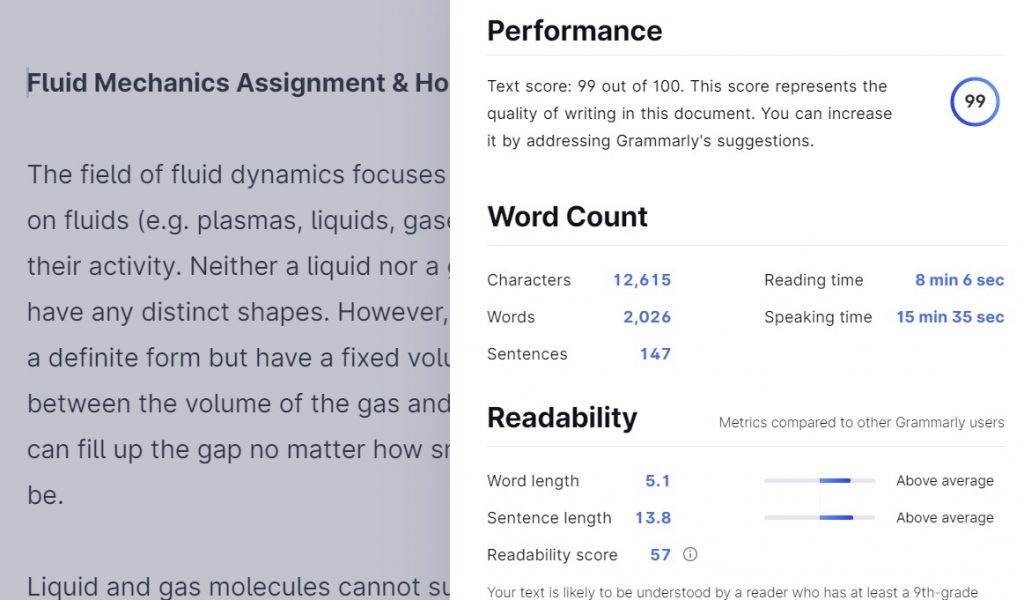
Viscosity
In this post, we’re going to talk about something called viscosity. So what exactly is viscosity? Viscosity is the internal friction within the fluid. So a good example to illustrate this is if you think of Honey and water. So let’s say if we have an inclined plane.
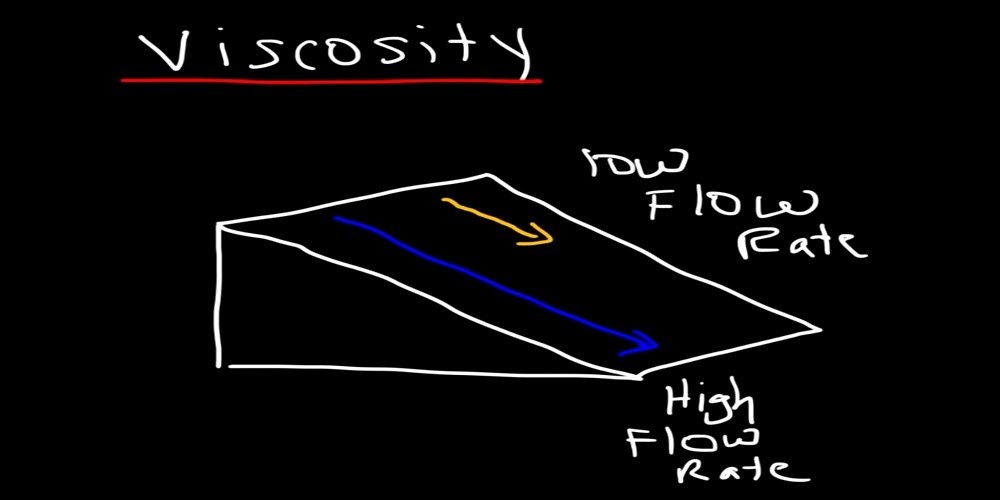
If we pour water at the top of the surface, the water will quickly slide down the inclined plane. But now, let’s say if we pour some honey, the Honey will slowly drip down. So water has a high flow rate relative to Honey, and In comparison, Honey has a very low flow rate. And the reason why Honey has a very low flow rate is that it has a very high viscosity. So the symbol, ETA (η), is the coefficient of viscosity. Viscosity for water is relatively low. And so that’s the basic idea behind viscosity. It represents the internal friction within a fluid.
So how can we quantify it? Here’s another example, let’s say if you have a stationary plate. (See below)
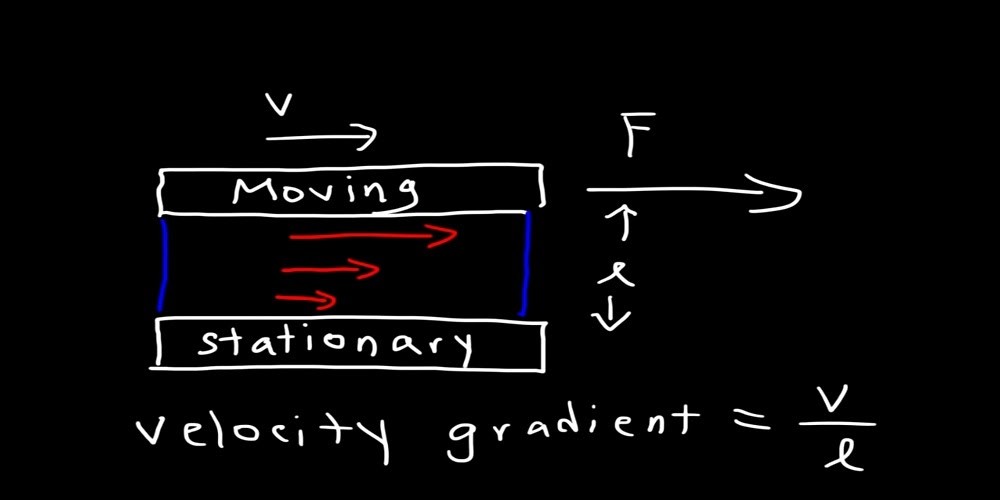
So this plate is fixed and its position, it doesn’t move, and above it, you have a moving plate. And to move at a constant speed, you need to pull it with force. And in between the plates, we have a fluid. Now there’s going to be a velocity gradient. The fluid next to the stationary plate will not be moving at all, but as you go up, the velocity will gradually increase. The distance between the two plates Is the length (L). The velocity gradient Is the ratio between the velocity. And the length between the two plates:
Velocity Gradient =VL
So to calculate the required force that will keep the upper plate moving at a constant speed, here’s the form that you need. So that required force is equal to the coefficient of viscosity, which is the Greek symbol ETA, multiplied by the area of the plates, times the velocity divided by the distance between plates.
F = ηAVL
So as we could see, the required force is proportional to the coefficient of viscosity. So as the viscosity of the fluid increases, it’s going to require more force to keep the upper plate moving at a constant speed. And if you increase the area, the required force will increase. To move the plate at a greater speed, you need to increase the force, so an increase in the speed, Is proportional to the force required, and the force required is proportional to the velocity gradient. However, the force required is inversely related to the distance between the two plates. Notice that length (L) is at the bottom of the equation so if you increase. The distance between the two planes, the required force will decrease.
Relationship between Temperature and Viscosity
If you increase the temperature of a liquid, the coefficient of viscosity decreases. To illustrate this, let’s return to our Inclan Plain.
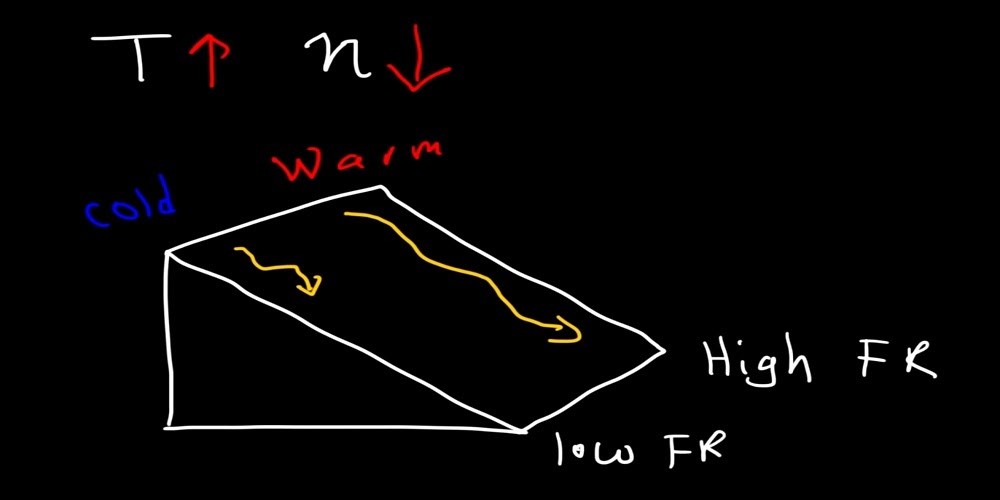
This time we’re going to pour warm Honey at the top and also cold Honey. If you try this experiment, you’ll find that the warm Honey will flow down faster along the inclined plane, whereas the cold Honey will travel slowly. So the warm Honey has a very high flow rate, which I’m going to abbreviate with FR, while the cold Honey has a low flow rate.
So by increasing the temperature of the liquid, you can decrease the liquid’s resistance to flow, decrease the coefficient of viscosity or its internal friction. So why does that happen? Whenever you increase the temperature, you can cause molecules to move apart from each other, and as they move apart, the cohesive forces that keep them together are now a lot weaker. So all of the intermolecular forces like London dispersion forces, dipole interactions, hydrogen bonds. Because the molecules move apart, and those interactions are weaker. To illustrate this, imagine if we have two ions. A positively charged ion and a negatively charged.
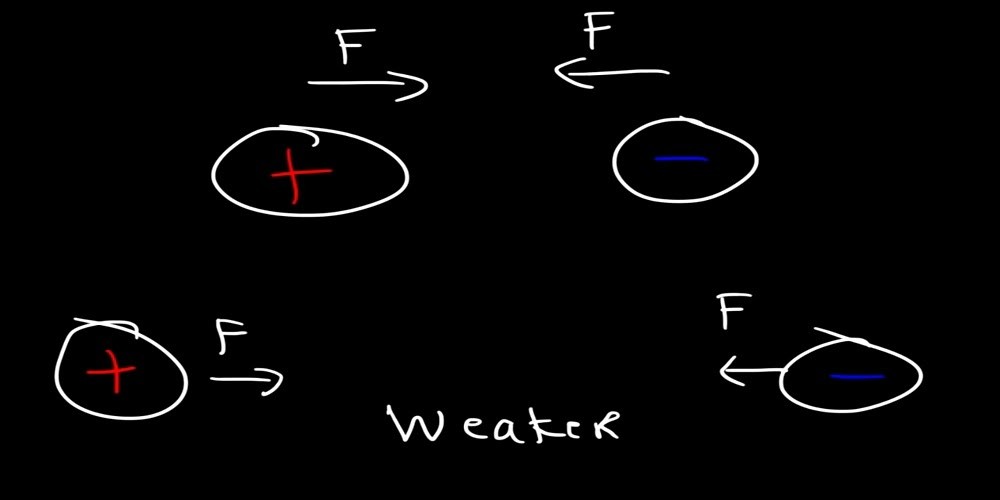
We know that these two ions have a force of attraction that pulls them together. But now that electrostatic force of attraction, is it stronger or weaker when the ions are further apart? Now, you’re still going to have a force of attraction, but that force of attraction is weaker when they’re further apart. To illustrate this, think of a bar magnet. If you have two bar magnets, when you put those two bar magnets close together, you can feel the force of attraction between them if you place the North Pole of one magnet to the support of the other. But as you move the magnets apart, the force of attraction decreases. And so what happens is whenever you raise the temperature, the molecules move apart. As they move apart from each other, the force of attraction keeping them together weakens due to the increased distance.
So when you heat Honey, the molecules move apart, there are less cohesive forces within Honey, and so the internal friction reduces. And that’s why, Honey, the molecules can flow past each other a lot easier at a high temperature. And so that’s why the viscosity of a fluid decreases with an increase in temperature. The molecules move apart, allowing them to flow past each other with much more ease.
Example
A force of 1.9N is required to move the upper plate at a constant speed of 0.25 meters per second. In the figure shown below. The area of the plate is 0.5 square meters, and a distance of one centimeter separates them.
- Calculate the coefficient viscosity of the fluid between the two plates.

So we know that the required force is equal to the coefficient of viscosity, times the area, times the velocity gradient.
F = ηAVL
So the force in this example is 1.9. Our goal is to solve for ETA (η). The area is 0.5. The velocity is 0.25. And the separation distance, that’s 1 centimeter. So we’ve got to convert that to meters by dividing it by a hundred, so that’s 0.1 meters. So 0.25 divided by 0.01 times 0.5. So on the right side, that’s 12.5. So what we need to do is take 1.9 and divide it by12.5 So the coefficient of viscosity is 0.152. Pascal’s time seconds, so that’s the unit for the coefficient of viscosity.
- Calculate the velocity gradient
The velocity gradient is simply the velocity divided by the separation distance, so it’s 0.25 meters per second. Divided by 0.01 meters. And so it’s going to be 25 one of a seconds. And so that’s the velocity gradient in this problem. (See the calculations below)

Now, let’s talk about the units of the coefficient of viscosity so if we solve for ETA (η).
F = ηAVL
To do that, we need to multiply by length (L). And then, we’ll have a F times L is equal to ETA times area times velocity, and then we need to divide both sides by AV.
FLAV= ηAVAV
So the coefficient of viscosity is the force times the length divided by the area times the velocity. The force is in Newtons, and the length is in meters, the area is square meters, and velocity is meters per second.
η = FLAV= NM squared
So we could cancel meters, so what we have is newtons divided by square meters times one of the seconds, so if we multiply the top and bottom by seconds. They will cancel. And so the units that we have now are Newton’s times, seconds over square meters.
NSM Squared
Now the pressure is Force over the area. And force is measured in new areas, square meters, so one Pascal is one Newton per square meter. So we can replace Newtons per square meter with Pascal’s, and so the unit for the coefficient of viscosity is Pascal’s times seconds. So that’s for those of you who want to understand why the units are the way they are.